Karat in Diamonds Not Just a Number
Karat in Diamonds Not Just a Number
Every time I hear the word "karat," my mind drifts back to the moment I first stepped into a jewelry store with my grandmother. She was hunting for the perfect ring to mark a significant milestone with her bridge club friends—fifty years of gatherings over tea and cards. Standing there, surrounded by the sparkle of countless rings, I naively assumed that the bigger the diamond, the better. However, my grandmother—wise and experienced in the ways of both jewelry and life—took me aside and quietly said, "It's not just about the size, dear; it's about the karat."
That day, I learned that when it comes to diamonds, the term "karat" is essential, yet often misunderstood. In the world of precious stones, "karat" refers to the measurement of a diamond's weight, not its size. One karat is equivalent to 200 milligrams. While this might sound small, consider it like a single raindrop in a thunderstorm, a tiny part of something much larger and significant within the story of a gemstone.
The diamond industry revolves around the famous four Cs: carat (or karat), cut, color, and clarity. Of these, karat often catches the limelight, but focusing on karat alone can be misleading. A diamond’s beauty and value aren't solely determined by its weight. The cut—how well the diamond is shaped and the angles precisely chiseled—can enhance a diamond's brilliance, making a smaller karat diamond outshine a larger one. This testifies to the diamond's craftsmanship, much like an artist perfecting their masterpiece.
It's fascinating how the perception of karats varies across different cultures and times. In some cultures, larger karat numbers are interpreted as a sign of wealth and prestige, almost like driving the latest luxury car. However, recent trends among Western millennials have shown a shift towards valuing uniqueness and sustainability over sheer size. A beautifully cut, ethically sourced diamond is now often preferred, offering a connection to the story behind the stone, rather than just its physical attributes.
On a more personal note, I recently found myself on the quest for the perfect engagement ring. Remembering my grandmother’s words, I asked questions and learned about the journey of each diamond. I came across a modest, yet brilliantly cut diamond that sparkled with a story. It wasn't the largest or most expensive stone in the store, but it spoke to me, just as the stars might speak to a dreamer on a clear night.
The next time you find yourself gazing at a diamond, whether in a piece of jewelry or behind a shop’s glass facade, remember that within its seemingly simple sparkle lies the complexity of karat—a weight that carries history, culture, and personal sentiment. It’s a reminder that value is often found in the details, not just the scale, and that true beauty is in how a diamond resonates with one’s own heart.
And as we walked out of that store years ago, clutching the carefully chosen ring, my grandmother whispered, "Now that’s a treasure." I couldn't agree more, for it wasn't just a ring; it was a lesson elegantly wrapped in karats.

























